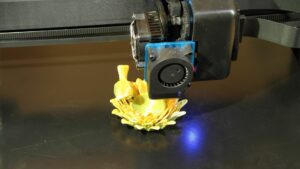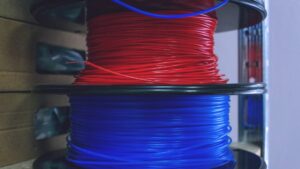
A Look at the Different Densities of 3D Printing Materials
There’s so much to learn about 3D printing materials. Come and find out what to look for when examining the different densities of 3D printing filaments.
844-810-1385
The old adage says, “If you can’t stand the heat, then get out of the kitchen.” The same thing goes for 3D filament; some projects just need to not wither under the heat.
As a 3D printing pro you have the power to choose the best filament for the job at hand. Sometimes, though, a little help from the experts can make that job a lot easier and less stressful. And picking the right high temperature filament is one of those times. In this post we’ll cover the most popular high temp filament for fused-deposition modeling printing, and give you the knowledge to put you at ease with your project.
Before we delve into the filaments, however, it might be best to first define at least one parameter. We need a standard so that comparisons are meaningful, and that standard is Heat Deflection Temperature (HDT). That is, the temperature at which a plastic sample deforms under a specified load. For our purposes today we’re going to use the Test Method ASTM D3418. You can find the details of the test here, but since we are doing a comparative analysis, we won’t go too far into the weeds.
Now, let’s see what is available.
We’ll begin our journey with PETG, or polyethylene terephthalate glycol if you’re into big words (or chemistry). This 3D printing material is a great high temperature choice for beginners because it prints just as simply as PLA (polylactic acid) but is better equipped to handle heat, water, and corrosive materials. In fact, its Heat Deflection Temperature is a toasty 65° C (compared to PLA at 54° C). Additionally, PETG tends to print more cleanly and smoothly along layer boundaries when compared to a polymer such as PLA.
As a bonus, PETG’s strong moisture- and water-resistance makes it a great material for watertight and weatherproof applications. And its chemical structure makes it suitable for projects that require resistance to corrosive materials. In fact, some gasoline tanks are made of PETG (don’t try this at home, kids).
ABS—acrylonitrile butadiene styrene—is a frequently used thermoplastic filament among experts due to its stiffness and resistance to heat. It is often used for products that will be exposed to high-stress conditions such as heat or impact and its Heat Deflection Temperature is a balmy 98° C. ABS has better layer adherence and creates a smoother print compared to many other filaments, though it does give off noxious fumes and is a bit finicky when it comes to print temperature settings. Printing inside an enclosure is highly recommended.
Polypropylene, also known as PP, is widely recognized for having exceptional resistance to a variety of chemicals, particularly to alkalis, acids, and organically volatile compounds. But not all polypropylene is created the same. Some grades of filament can reach an HDT higher than ABS at 100° C while others are as low as 54° C; buyer beware. Because it is transparent it’s frequently used for plastic containers, beverage bottles, and other printed items that come in contact with moisture or harsh chemicals when visibility is required.
A close cousin to PP, PP GF30 is polypropylene with 30% glass fiber mixed in, giving it a Heat Deflection Temperature of 120° C. Its excellent thermal- and chemical-resistance and strength make it popular for the automotive and aerospace industries.
But PP has a dark side too – it can be notoriously difficult to print. The shrinkage can be problematic, and it is temperature sensitive like ABS.
Does your project require some flexibility in addition to handling high temperatures? Then nylon copolymer may be your E-ticket. Like PP, its HDT is 102° C — plus, it can tolerate that temperature for a long periods of time. Due to its semicrystalline form, nylon copolymer is also semi-flexible, making it an outlier among 3D printer filaments. Due to its strong heat-, abrasion-, grease-, and impact-resistance, nylon copolymer is widely used to print industrial and mechanical components.
Downsides? Not if you are careful. Nylon copolymer is hydroscopic, meaning it picks up water. And this water is the enemy of a good 3D print; it causes stringing when the filament is retracted to move the hot end to a new location. But if you dry the filament before starting the print and keep dry during long print sessions, you will be rewarded with uniquely qualified prints.
In a shameless plug (this is how the Interweb works, you know) may we suggest you take a peek at Filamatrix’s Phoenix Copolymer High-Temp Nylon filament. It’s an affordable workhorse in the industrial workspace.
The Grand Poo-bah of high temperature 3D printer filament (for the masses; NASA doesn’t count), carbon fiber reinforced polyamide (Nylon Carbon Fiber) is a very durable, very tough material. Its HDT is a whopping 150° C (300° F) and it has the chemical resistance found in all nylons. It is sometimes referred to as Black Aluminum, though its suitability as an aluminum substitute depends on your specific requirements. However, one cannot deny that it is far easier to print a Nylon Carbon Fiber part on your desktop than mill an aluminum bar in your office. Those shavings go EVERYWHERE.
But it’s nylon, you say, and that means you have to keep it dry while printing! Well, that is true, especially for longer printing times. But wait, there’s more! Filamatrix makes a Hydrophobic Nylon Carbon Fiber that, along with a slight improvement in heat resistance, you get the abrasion resistance of carbon fiber, and the ease of printing closer to PETG than nylon. If you start with dry filament, you can generally print for days before stringing becomes noticeable. We’ll have more on this in a forthcoming blog post.
Hopefully this overview of the top six (seven?) most heat-resistant 3D printing filaments on the market has been helpful. Your options may seem overwhelming, but taking the time to learn about each filament will make it easier to confidently pick the perfect filament for each project you’re looking to print. But if you’re still unsure, Filamatrix has experts that print with our filaments every day, and we’re here to help make the best choice. Drop us a line.
Due to its wild popularity, this blog post was updated on 20 June 2023. It now includes shameless, self-promoting links to products but it also contains a LOT more usable information.

There’s so much to learn about 3D printing materials. Come and find out what to look for when examining the different densities of 3D printing filaments.

Those interested in 3D printing have a lot to learn on how to use the system properly. Find out what you need to know about 3D printing and humidity levels.

3D printing has many variables that both beginners and experts need to know. Find out what effects temperature has on 3D printer filament.
Get professional insights, industry news, and our latest deals